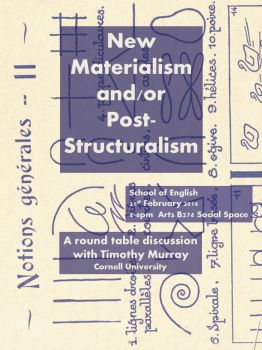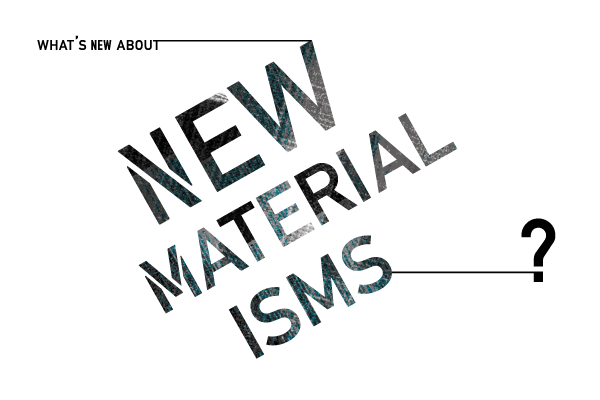
Three weeks ago I went to a round table discussion at Sussex University on ‘New Materialism and/or Post-Structuralism’, which featured Timothy Murray (Cornell), Seb Franklin (KCL), Jussi Parikka (Anglia Ruskin), John David Rhodes (Sussex), and Michael Jonik (Sussex). As this was mostly a discussion, my notes underneath are a bit fragmented and as I only wrote them up three weeks later, they might not be really coherent at some places either, but there you go. The panel discussed ‘what is at stake in our current moment as the poststructuralist legacy encounters new thinking concerning materialism, embodiment, networks, art/technology, performance, and/or archives’. One of the main drawbacks of the event, which was duly noted by the speakers—but nonetheless—was the lack of female speakers, which is of course non-excusable for any academic event, but especially in this context one could argue, with respect to new materialism’s strong roots in the feminist tradition.
Timothy Murray in his introduction talked about the notion of the and/or in the title. Should we draw a distinction between the two (or) or should we see them as connected (and)? Should we be thinking outside of the dialectic? Murray, who calls himself a materialist, then talks about the positionality of the legacies of the philosophies of the subject and definitions of the cultural. He sees new materialism as engaged with adopting paradigms that have come out of Deleuze and Guattari’s collaborative work (not out of their separate works). Murray states that new materialism is mostly affected by the idea of the rhizome from Mille plateaux. He also refers to the work done by Foucault in The archaeology of knowledge and the role of questioning in this work. Murray wonders in this respect whether the threat of humanist thought that poststructuralism has fought against is coming back. We need to think the material and the subject together and focus on the multiplicity of the term new materialism(s).
Jussi Parikka focused on the other kind of lineages of (re) reading Foucault that we can for instance find in German media theory. Parikka discusses new materialism more broadly and its resonances across a variety of fields, from strong links with poststructuralism, where it seems to dismiss the cliché readings of poststructuralism and its focus on textuality and deconstruction, to links with feminist materialism (Braidotti) and feminist theory, which itself has a strong link to poststructuralism. Through the new materialism older theories are being reread, Parikka states. Think of Braidotti’s 90s Deleuzian feminism, as a rereading of Foucault and Deleuze. But there are also important figures such as Manuel De Landa and Elisabeth Gross, as well as Karen Barad, that have been highly influential.
Parikka then narrates how he has been involved in organising the 1st conference on new materialism (New Materialisms and Digital Culture) and the second one in Utrecht, where this year the 5th one is held in Barcelona. He states that all had a strong link with the gender issues agenda. The political stakes are different in this respect than for instance in OOO, where the latter wants to denounce the link with poststructuralism more. In new materialism however, and mostly within the arts and humanities studies, there is a focus on thinking outside the linguistic and the representational. There is a focus on visual performativity and ethnographic work with artists for instance. There has also been an international discussion deriving from science and technology studies, i.e. from the likes of Donna Haraway and the work of Karen Barad on onto-epistemologies and intra-actions. Here the focus is on ontologies that are material. New materialism is involved in rereading traditions and through them engages in a reiteration of what other methodologies we have. New materialism misses a black feminist link with the postcolonial and black studies however, Parikka argues, following Sara Ahmed, traditions which all also have a long link with the material and which we need to engage with. Parikka concludes that the alignments that define the feminist new materialisms are a continuation of Deleuze and Foucault through political engagement.
If we talk about specific locations, Parikka argues, then we need to mention the Utrecht school of gender studies. He mentions the COST action network on ‘how matter comes to matter’ that is led by Iris van der Tuin. It has to do with knowledge production and epistemologies and how these are equipped to deal with the economy, the political, ecology, crisis, technology etc. How can practices of knowing be reconceptualised in this respect? How do you develop concepts from the material, in a kind of Latourian bend? Parikka also mentions media archaeology and German media theory. Kittler and Ernst are important examples here, for instance the way in which they have studied archives as technical material platforms. German media materiality fits in with some of the points raised by new materialism but does not have a strong feminist agenda however. Parikka argues the importance in new materialism of the idea of constructing knowledge from material, technological and institutional practices. The notion of cultural techniques as discussed in Theory, Culture and Society, is important here. We need to understand key concepts in the humanities through their key links to technology and machines. When it comes to materiality we need to think beyond the human body towards things that are escaping our phenomenological ideas of the body and the sensational. We need to focus more on non-objects such as waves and frequencies too. And how can we for example extend notions of materiality outside media before things are media?

The idea of new materialism is based on the idea that we already had all kinds of materialisms such as in Marxism. There is a material shifting here from the Marxist means of production etc. to things having to do with embodiment, where there are also links with for instance affect studies and performance studies. Here the focus is on the non-representational, the living and acting bodies that are not restricted by materiality. The other focus is on how new materialism relates materiality to new media etc. We shouldn’t be thinking about matter as being inert, Parikka argues, where all activity happens in the human body and mine. But matter is dynamic, meaning does not only come about when we project it on matter. Matter matters, matter is dynamic, or, as Jane Bennett has argued, matter is vibrant. The question of agency and of political agency is important here too. Barad explores the idea of intra-agency, of matter as dynamic in this respect. How does this complicate political possibilities?
Seb Franklin talked next about the relationship between new materialism and political concepts such as labor and value production, related to the relationship between new materialism and historical materialism. New media, he argues, create new practices, but also new metaphors which get employed in different contexts. Franklin has therefore explored the genealogy of the computer metaphor and its influence on labour and the political economy. He talks about Italian theorists such as Lazzarotto, Virno and Negro and concepts such as immaterial labour and cognitive capitalisms. Here the human is reconceptualised as an information processor. The social work becomes a communications network. He talked about Babbage and proto-computing machine metaphors. Metaphors here serve as a genealogy of information age capitalism, he argues.
Franklin states that new materialism has more of a critical function and a more ambivalent function. Deleuze and Guatarri write about flow and becoming and movement, but there is also the active mode of constant configuration. There is a parallelism here with modes of production. If these modes are based on fuzzy metaphors, how can we use these as a critique? How can a new materialism help us rethink political labor and capitalism and this whole Italian autonomedia tradition?
John David Rhodes finally argues that he is still very much invested in representation and still sees it as very important. Representation is a material itself as we can see from the resistant nature of the aesthetic. The art work is not that transparent and is a material itself and it has a certain stubbornness to it, it registers an encounter between a maker and a world. Rhodes argues that Jane Bennett in her book is for instance quite humanist. Humanism is important he argues, the political is plural and we are more than materials. Agency and humans thus remain important.

Timothy Murray goes on to discuss the new in new materialism and the feminist role in all this. He discusses the tension between French feminism (Irigaray and Cixous) and their relationship with French philosophy, representationalism, and Marxist philosophy on the material body. How the rise of black feminism in the UK and the US came together in postcolonialism and post colonial theory (Stuart Hall, Bhabha, Spivak). This history seems to be leaped over with the idea of the new.
Parikka then wonders what the task of new materialism is? He sees it as a mapping of the history of poststructuralisms and other histories of thought that lead to key issues having to do with the body and the material and the relation to Marxism. Haraway’s work is important here, as is De Landa’s (known for his physics and Deleuze driven account of self-organising matter). New materialism is for Parikka a kind of cross-breading of traditions in a heretic way. New materialism can also be seen as a critique of the narrow understanding of the human in our current condition. How can these radical ontologies in relation to the human develop? This implies a redefinition of the human and of what constitutes the human, from financial capitalism to bacteria. It is a mapping of what kind of other methodologies exist.
One of the questions afterwards focuses on poststructuralism as a linguistic tradition. Murray responds that it is a popular assumption that poststructuralism is only a literary critical tradition which is primarily linguistically based. This is just not the case, he argues, this refers to only one brand of reception of Derrida’s work in the States. Writing was always seen as broadly material in the poststructuralist tradition (French Écriture féminine etc.). Theories of representation is what new materialism is against for they foreground the thinking human or subject over the material and make distinctions between the subject and the object. Parikka argues that there is a distinction between the linguistic and the vital materialist camp of Deleuze and Guattari. This has branded some of the new materialism. They are probably more Deleuze and Foucalt based than Derrida. There is this insistence on Foucault as a thinker of discourses but he is fantastic when to comes to the non-discursive too.

Leave a Reply
You must be logged in to post a comment.